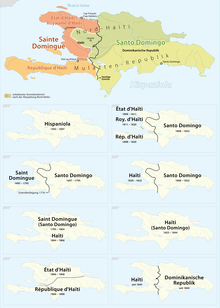Northern Haiti
As Northern Haiti , in addition to the Haitian department of Nord different about the northern half of Haiti called extending the creation of states of the 19th century.
State of Haiti
With the breakup of the entire island of Haiti in October 1806, the northern part of the island under President and Generalissimo Henri Christophe first became the black-dominated state of Haiti (État d'Haïti), while in the south the mulatto-dominated Republic of Haiti under Alexandre Sabès Pétion was founded. The capital of the north was Cap-Haïtien , the capital of the south was Port-au-Prince . The eastern part of the island (Santo Domingo) was lost again to the Spanish in 1808.
After 1808, the northern state comprised about four of the ten current departments of Haiti: Artibonite , Nord , Département Nord-Ouest . Most of Center belonged to Santo Domingo after 1808.
Kingdom of Haiti
Henri Christophe converted the northern state into a hereditary kingdom of Haiti (Royaume d'Haïti) in March 1811 and had a magnificent residence built in Sans Souci (near Milot , 12 km south of Cap-Haïtien). After his suicide in 1820, Henri was finally buried in the La Ferrière citadel , built 27 km south of Cap-Haïtien and 8 km from Milot to protect against invasions . With Henri's death and that of Crown Prince Jacques-Victor Henry, the division of the island state also ended, Haiti was reunited by the southern President Jean-Pierre Boyer , and in 1822 the Spanish eastern part of the island was also recaptured.
Northern counter-governments
In the civil wars that broke out since the fall of Boyer (1843), the eastern part of the island finally split off as the Dominican Republic in 1844 , and Northern Republics were repeatedly proclaimed in the northern Haitian city of Gonaïves ( Artibonite department bordering north ). However, it was not so much a matter of establishing separate states, but rather of short-lived counter-governments, whose presidents were also able to prevail a few months later in Port-au-Prince and South Haiti.
- 1844 Republic of North Haiti under Philippe Guerrier
- 1868–69 Republic of the North (République du Nord) under Nissage Saget
- 1888–89 Northern Republic (République Septentrionale d'Haïti) under Florvil Hyppolite
Gonaïves 2004
In February 2004, a counter-republic was proclaimed under Buteur Métayer in Gonaïves (République d'Artibonite), and the popular movement it triggered led to the overthrow of the then President Jean-Bertrand Aristide in March and the intervention of the USA. Shortly afterwards, the 2004 Atlantic hurricane season almost completely destroyed Gonaïves.






